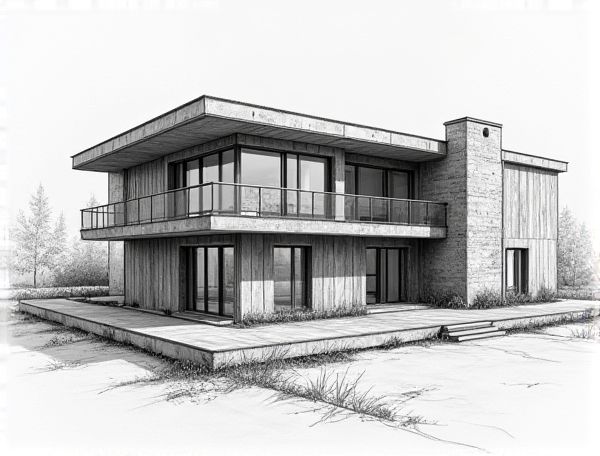
Photo illustration: Urban industrial home design with exposed ductwork and Corten steel accents
Urban industrial home design emphasizes raw, unfinished materials like exposed ductwork and weathered Corten steel accents to create a bold, edgy aesthetic that blends modern functionality with rugged charm. Explore how these elements can transform your living space by reading more in the article.
Introduction to Urban Industrial Home Design
Urban industrial home design combines raw, exposed materials such as brick, metal, and concrete with modern aesthetics to create a functional yet stylish living space. This design style emphasizes open floor plans, large windows, and utilitarian elements that reflect the urban landscape and industrial heritage.
Key Elements of the Urban Industrial Aesthetic
Exposed brick walls, metal accents, and reclaimed wood flooring define the urban industrial aesthetic, creating a raw yet refined atmosphere in your home design. Large windows, open floor plans, and utilitarian light fixtures enhance the space by combining functionality with a modern, edgy appeal.
Embracing Exposed Ductwork: Function Meets Style
Exposed ductwork in home design combines industrial aesthetics with practical ventilation, creating a modern and airy atmosphere that enhances spatial perception. Incorporating sleek metal ducts and strategic lighting highlights architectural features while maximizing energy efficiency and airflow.
The Allure of Corten Steel in Modern Interiors
Corten steel's distinctive rust-like appearance creates a warm, earthy aesthetic that seamlessly blends industrial charm with contemporary design in modern interiors. Its weather-resistant properties ensure durability and low maintenance, making it ideal for feature walls, fireplaces, and accent furniture. The material's unique texture and rich patina develop over time, adding depth and character to any living space.
Blending Raw Materials for Textural Contrast
Blending raw materials such as reclaimed wood, exposed concrete, and natural stone creates a dynamic textural contrast that elevates home design by adding depth and tactile interest. Incorporating finishes like matte metals and rough linens further enhances this interplay, resulting in a harmonious yet visually compelling living space.
Color Palettes for Urban Industrial Spaces
Urban industrial spaces thrive with color palettes that emphasize raw materials like exposed brick, concrete grays, and metallic tones paired with rich, deep shades such as navy blue, charcoal, or burnt orange to create contrast and warmth. Incorporating neutral hues like black, white, and taupe balances the rugged textures, while pops of vibrant colors like mustard yellow or forest green add visual interest and modern sophistication.
Furniture Choices to Enhance Industrial Vibes
Incorporating reclaimed wood and metal furniture pieces enhances industrial vibes by emphasizing raw textures and sturdy forms that reflect urban loft aesthetics. Choosing minimalist designs with exposed hardware and neutral tones complements the rugged, functional character essential to industrial-style interiors.
Lighting Ideas for Industrial Ambience
Utilize exposed Edison bulbs and pendant lights with metal finishes to enhance the raw, rugged charm of an industrial space. Your lighting choices should emphasize warm, ambient glows combined with adjustable fixtures to highlight architectural elements like brick walls and steel beams.
Tips for Balancing Warmth in Industrial Homes
In industrial home design, balancing warmth requires incorporating natural materials like reclaimed wood and soft textiles alongside metal and concrete surfaces. Use warm lighting fixtures, such as Edison bulbs or lantern-style lamps, to create a cozy ambiance while maintaining the industrial aesthetic. Integrate plants and warm-toned accents like leather furniture or area rugs to soften the space and enhance comfort.
Sustainable Practices in Urban Industrial Design
In urban industrial design, sustainable practices prioritize the integration of eco-friendly materials, energy-efficient systems, and waste reduction techniques to minimize environmental impact. Incorporating green roofs, solar panels, and adaptive reuse of existing structures enhances resource efficiency while fostering resilient, low-carbon urban environments.
 homedesy.com
homedesy.com